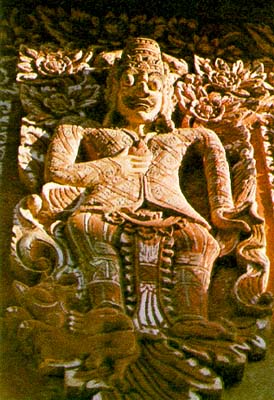
Sempidi
|
|
These
villages west of Denpasar, are noted for decorative temple sculpture.
Carvings of domestic scenes and mythological episodes are mischievously
exaggerated and painted in bright colors, reminiscent of the exuberant
North Balinese style of sculpture. The aphorism-the more you look, the
more you see-certainly rings true here, especially at the Pura Dalem of
Lukluk and the three desa temples of Sempidi.
|

|
|
The most
important temple in this area is Pura Sada in Kapal, an ancestral
sanctuary honoring the deified spirit of Ratu Sakti Jayengrat whose
identification remains uncertain. (According to one story he was a
noble from Majapahit who came to Bali by sea, kapal means "ship"-his
vessel being wrecked on a reef where the village now stands).
|
|
The
original foundation of which may be as old as the 12th century, was
rebuilt during Majapahit times by one of the early kings of Mengwi,
perhaps in the 16th century. The oldest of the Mengwi state shrines,
predating Pura Taman Ayun, Pura Sada was destroyed in the great
earthquake of 1917 and restored by the Archaeology Service in 1950. A
large brick candi or prasada, ornamented with modern statues, dominates
the complex.
|
|
Seven
Saints adorn the body of the candi, and at the top are the Nine
Gods-the lords of the eight directions and of the center. The temple's
64 stone seats are believed to commemorate faithful ' followers who
died in battle and are reminiscent of megalithic ancestral seats.
|
|
Just
outside Kapal village, on the opposite bank of the river, grows a
unique coconut tree with a split trunk, bearing fruit on both branches.
Nearby stands a huge Banyan tree with a complete temple built in its
branches.
|
Copyright
2001-2015, K&D Bali Designs. All rights reserved.
|